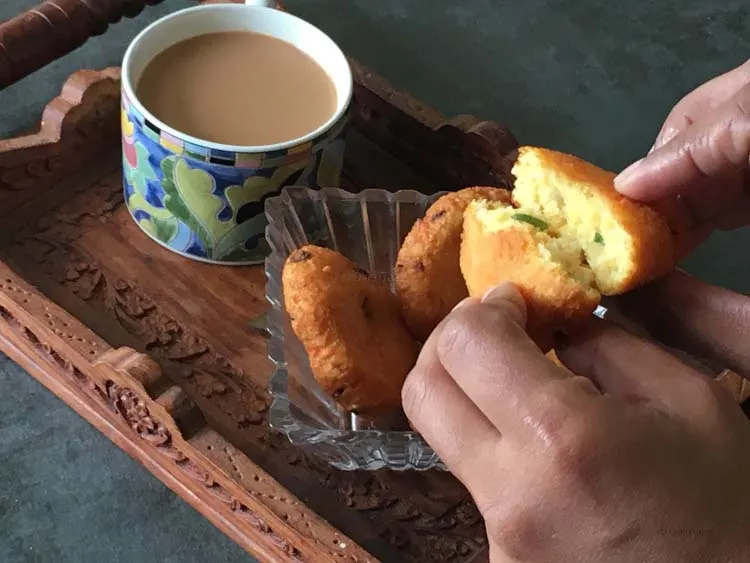Medu Vada is a popular south Indian ( and Sri Lankan) snack. These are ring shaped fritters that you could mistake for a doughnut at the first glance. Vada usually means fritter and medu vada translated to soft fritter and that is what these are – crunchy and crispy outside and soft and spongy inside. It is rarely that you will find a South Indian who will say no to these.
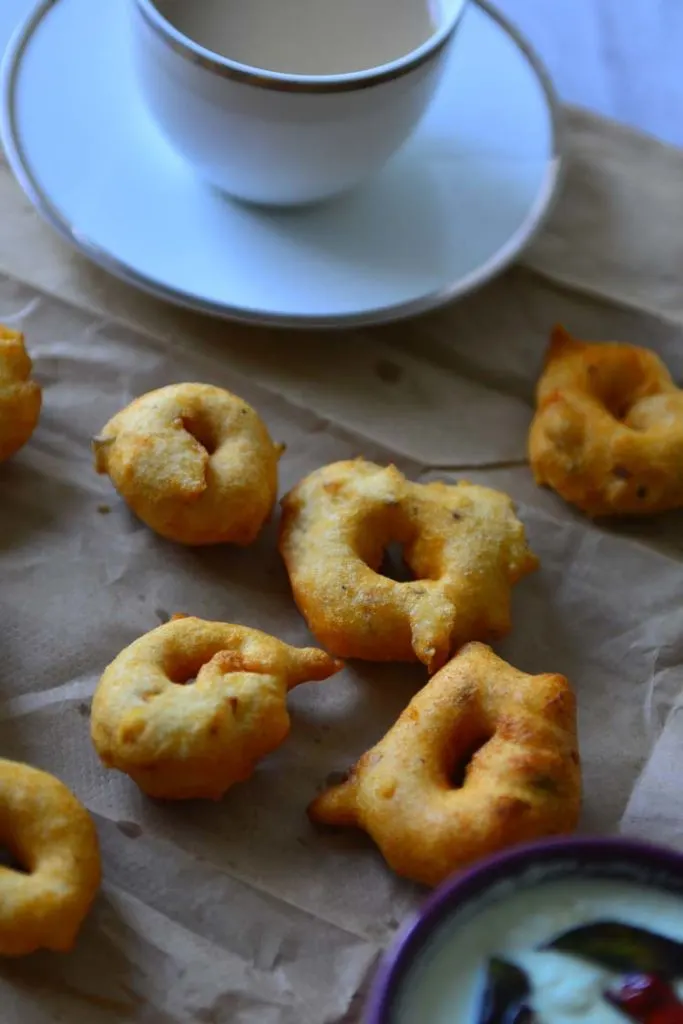
Walk down along any busy south Indian street on an evening and you are guaranteed to find at least a dozen of eateries selling these crispy rings. Sometimes these are served plain along with a small bowl of coconut chutney , and other times time these are served dunked in yogurt or sambar. Either way these are a delight to munch on .
So how popular are these ? Let us see – these are known as uzhunnu vada in Kerala , garelu in Andhra, ulundu vadai in Tamil Nadu and uddina vada in Karnataka. So one might think that if you travel across state lines it might be a bit difficult to order these. Well that is not the case – just ask for vada vada or medu vada and you will be served these. wont that be considered popular !
Medu Vada is made with split black gram or urad dal , and spices. Black gram looks very similar to Mung beans, but with black skin and creamy white bean.The skinned urad dal is soaked in plenty of water for at least 3 hours and ground into a paste. It should look plumped up after soaking. Just crush one with your fingers and if the inside feels hard or dry soak for some more time. To this a few spices and seasonings are added and the thick batter is fried in hot oil.
These are not just a popular snack, but relished at breakfast time as well. This was the reason I was happy to go to any vegetarian hotel in Tamil Nadu for breakfast – no matter what you order – be it pongal, dosa, idli or poori you will get Medu Vada on the side. Trust me on this Medu Vada makes everything tastes batter.
These fritters have a lot going for them – other than looks and texture. These are made with black lentils. Like all lentils the black lentils are also packed with nutrients especially protein , calcium and iron. And these are delicious when cooked !
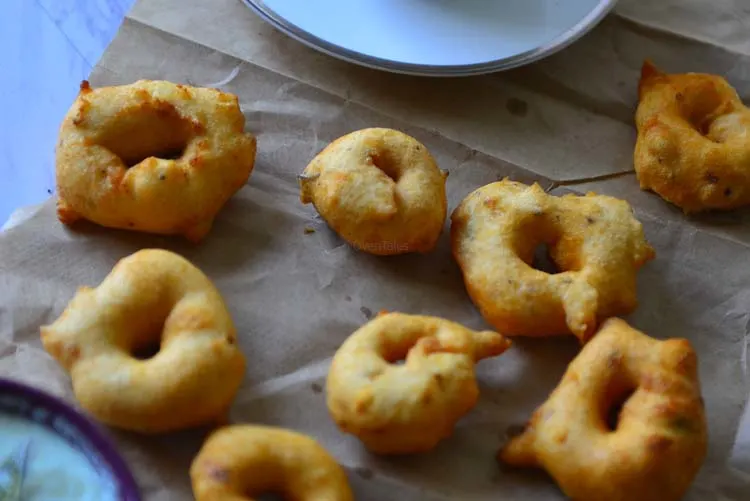
Healthy and delicious – there has to be catch right ? Well frying these in the doughnut shape is the tricky part. Why the ring shape you ask ? Well the hole in the middle makes it cook evenly, there is no volcanic explosion in the middle. Test out some just by dropping the same amount of batter , shaped and unshaped and you will see the difference.
But don’t be discouraged if you cant get the shapes right. The plain ugly dumplings taste good too. In the north they make Dahi Bhalle with these. These are basically the black gram dal fritters dunk in a sweet and sour yogurt mix. In the south too we love these dunk in spiced curd, but we would rather hold on to our doughnut shape 🙂 .
Getting these in the perfect doughnut shape is an acquired skill :-). So a few weeks back when a company in India came up with a packaged batter that can be poured straight into hot oil in to make perfect doughnut shaped vada – my entire social media universe lost its collective mind ! I am not sure how many Vada making videos ended up in my inbox and news feeds. It seems to have died down a bit – may be people have figured out that the shape is only part of the charm !
There have been other dispensers just like cookie press , that seem to do the job, but to me as much as I like to get these in the doughnut shape there is a bit of charm in a little uneven ,hand made creations.
Unlike doughnuts the batter for Uzhunnu vada is free of gluten. It is made up of a ground lentils and and spices. Think of the the batter as a textured whipped cream. There is enough air trapped in there to make it float in water. So rolling out and cutting to shape like we can do with cookies or doughnuts are simply out of question!
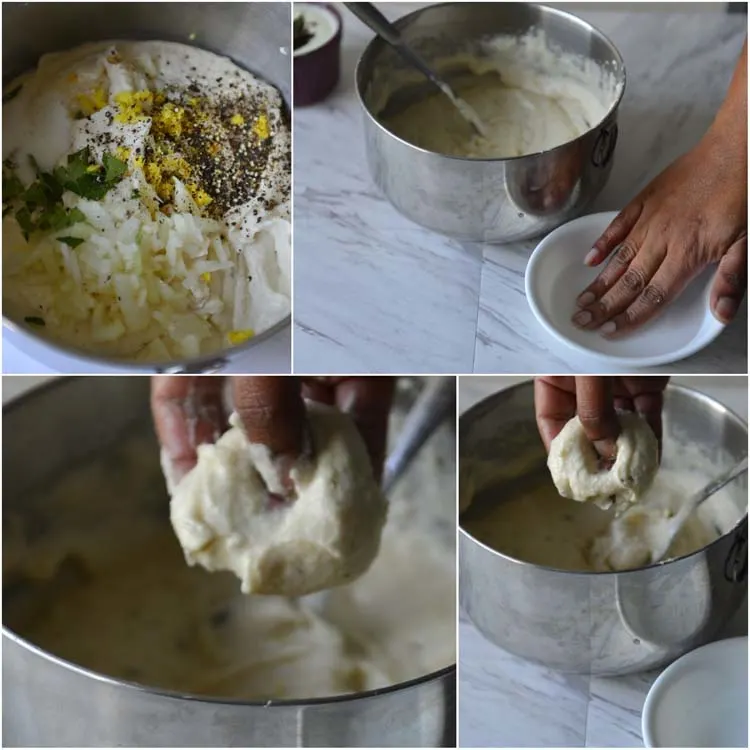 Home cooks have different ways of shaping these. Some used to take small squares of banana leaves and shape the batter on it and invert it gently to hot oil. I have seen it being made that way , but never tried it myself. Skilled cooks used to drop the batter into the oil and as it begins to fall into the oil they punch a in it with a finger, making the perfect shape. I have attempted it , but mine always turned out to be haphazard.
Home cooks have different ways of shaping these. Some used to take small squares of banana leaves and shape the batter on it and invert it gently to hot oil. I have seen it being made that way , but never tried it myself. Skilled cooks used to drop the batter into the oil and as it begins to fall into the oil they punch a in it with a finger, making the perfect shape. I have attempted it , but mine always turned out to be haphazard.
My go to method is to drop the batter by spoonfuls into the hot oil. Before the batter sets I poke a hole in the middle using the handle of a wooden spoon. This is the one that has worked for me for the most part. What I love about i this is that my hands are free and I can multi task, and I did not need to buy any special equipment !
Another one is to wet you palm lightly and shape the batter into a doughnut shape over the fingers and invert into the hot oil. The moisture prevents the batter from sticking to your fingers and it just slides off to the oil with a gentle nudge – remember I mentioned above that the batter floats in the water!
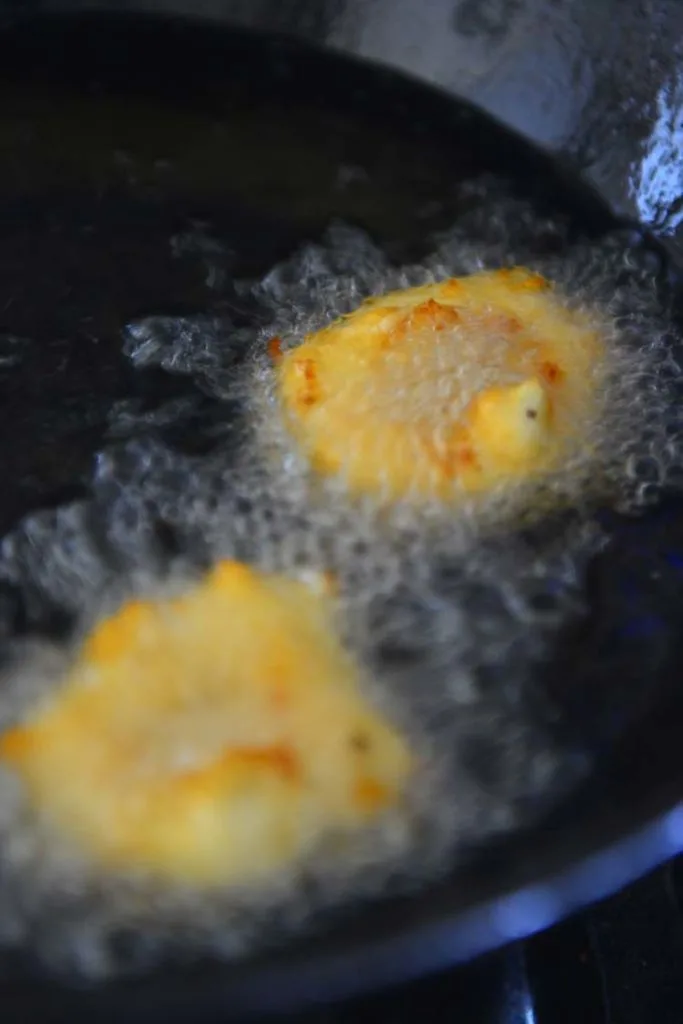
Couple things to keep in mind when making the vada batter – The vada should be made as soon as the batter is made. A few minutes of resting time is not going to make things go bad, but an hour would. The longer it rests , the more oil it will absorb. So when the cooks had to make large batches they used to split it and make the batter in batches.
The packaged batters in stores, seem to question this reasoning, especially when they claim to have added no preservatives or additives. If true then I imagine the degradation of the natter has to do with oxidization or fermentation breaking down the bonds between the particles in the batter. Following that reasoning we should be able to preserve the batter just by keeping it in a vacuum sealed environment it – or keep it in a closed container and cover the top of the batter with a plastic wrap or wax paper. This is purely conjecture a t this point – no experiment has happened yet. If anyone does, I will be really interested in knowing the results .
And finally – there are many home cooks who swear by their wet grinder – for those who don’t know these are powerful kitchen grinders that use granite grinding stones grind grains and seeds. I have made the batter in my blender and the wet grinder , and frankly I prefer the blender. The only thing to keep in mind is not to get the grinder and blender jar get hot. Luke warm is Ok , hot definitely is not.
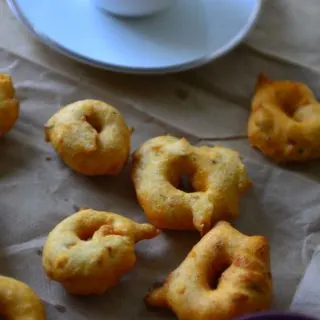
Medu Vada
Ingredients
- 1 C Urad Dal Notes
- Water As Needed To Soak
Seasonings
- 1/2 Tsp Minced Ginger
- 2 Tbsp Onions Finely Chopped
- 5- 6 Black Pepper Corns Crushed
- 1 Pinch Asafoetida Optional
- Salt To Taste
- 3-4 Curry Leaves Torn
Other Ingredients
- 2-3 Tbsp Cold Water
- Oil To Fry
Instructions
- Soak the urad dal in plenty of water and for at least 3 hours.
Make the batter
- Drain the soaked urad dal and grind into a smooth paste in a blender using as little water as necessary (2 to 3 tablespoons of chilled water). If the blender seems to heat up turn off the machine and let it cool before proceeding.
- The process of grinding incorporates air into the batter making it light and fluffy like whipping cream. Drop a little batter in a bowl of water. The batter should float.
- Transfer to a mixing bowl and add the chopped onions, pepper, curry leaves, ginger , asafoetida and salt to it . Mix well, taste and adjust salt as necessary.
Fry
- Pour oil into a frying pan covering the bottom by about 1 inch. Heat the oil to almost its smoking point. Drop a little bit of batter into the hot oil , if it sizzles and floats to top the oil is ready for frying.
- Wet the fingers and scoop a lemon sized ball of batter. Make a small hole in the center and slip it into the waiting oil . Repeat and make a few more vadas. (see pictures above)
- Keep the heat at medium to medium low and fry the vadas turning a 2 to 3 times to brown all sides evenly.
- When all sides are light brown , take off the oil using a slotted spoon and drain on kitchen towels. Repeat the process until all the batter is used up.
- Serve wit coconut chutney or sambar.
Notes
- Use skinned urad dal.
- Make the vada batter just before frying.
- Wet the fingers every time before scooping batter.
- All the seasonings except salt are optional !
- The vada batter can be shaped on a parchment or grease proof paper and transfer to the oil.
- Alternately drop one scoop of batter into the oil and push the handle of a wooden spoon right in the center to create a hole. Twirl the handle a few times to make the whole wider.
- Asafoetida might contain traces of wheat - so if you are looking for gluten free versions do not use it.
Important: Nutrition Values are estimates. Actuals vary based on ingredients and serving size.
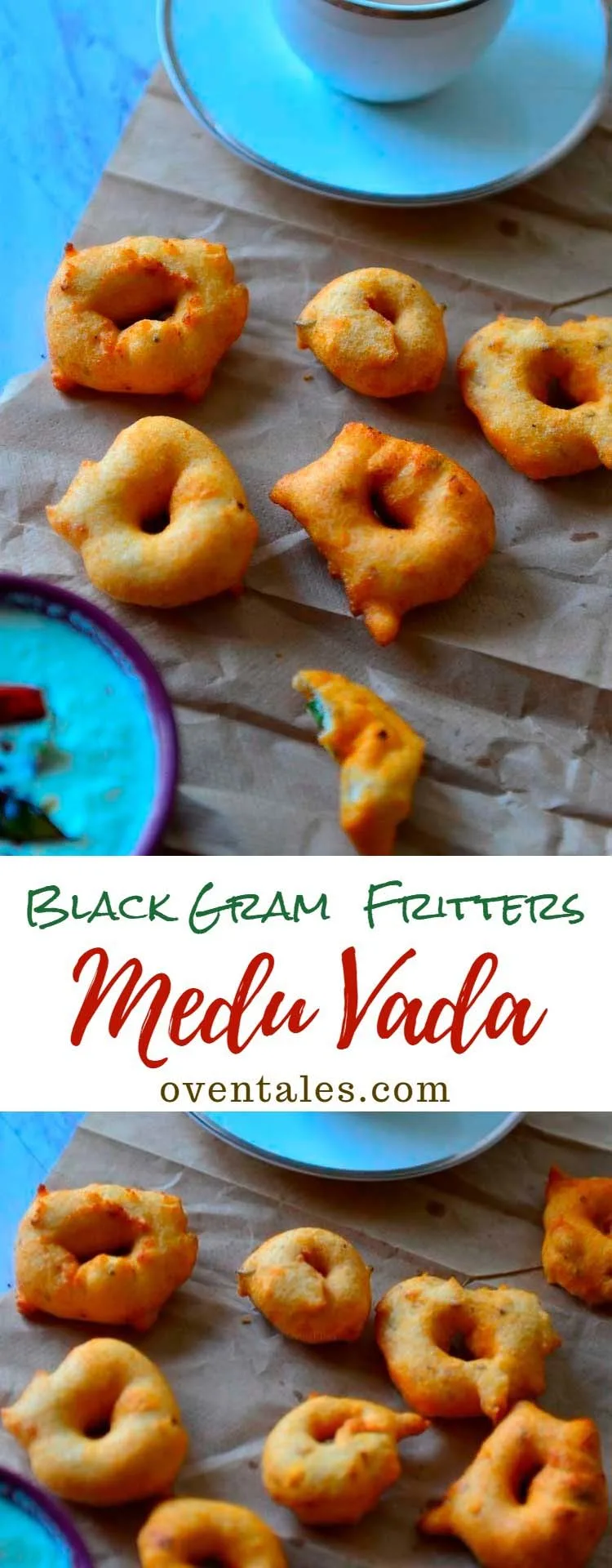
You might like these – Parippu Vada

